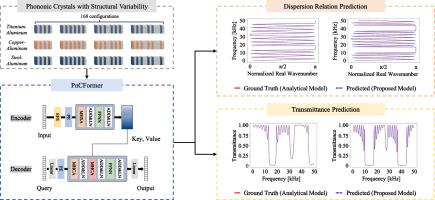Transformer-based prediction of dispersion relation and transmittance in phononic crystals
IF 9.4
1区 工程技术
Q1 ENGINEERING, MECHANICAL
International Journal of Mechanical Sciences
Pub Date : 2025-09-23
DOI:10.1016/j.ijmecsci.2025.110880
引用次数: 0
Abstract
This study presents PnCFormer, a transformer-based surrogate model tailored for one-dimensional phononic crystals (1D PnCs) with structural variability. The model is designed to accommodate variations in material properties, geometric dimensions, and the number and arrangement of unit cells, including defects. To address the challenge of variable-length inputs (a total number of unit cells), the system employs a padding and masking strategy, complemented by an enhanced feature embedding (EFE) that incorporates both basic given and wave-relevant engineered features. A frequency-aware decoder that utilizes frequency-domain queries (FDQ) facilitates precise prediction of both dispersion relations and transmittance frequency response functions (FRFs). PnCFormer is trained on a substantial analytically generated dataset encompassing 168 PnC configurations. The model demonstrates excellent agreement with ground-truth results, accurately capturing band gaps and defect bands in dispersion relations, and nearly zero and peak values in transmittance FRFs. The framework’s primary contributions are threefold: first, the integration of EFE for physically informed embedding, second, the implementation of FDQ for spectral prediction in parallel, and third, generalizable architecture that is adept at managing various structural arrangements. These innovations enable PnCFormer to perform rapid, high-fidelity spectral analysis across diverse 1D PnC designs. The model’s flexibility and accuracy suggest significant potential for applications in enhanced ultrasonic sensors and actuators for nondestructive evaluation, medical imaging, and prognostics and health management.

基于变压器的声子晶体色散关系和透射率预测
本研究提出了PnCFormer,一种基于变压器的替代模型,专门用于具有结构可变性的一维声子晶体(1D pnc)。该模型旨在适应材料特性、几何尺寸、单元胞的数量和排列(包括缺陷)的变化。为了应对变长输入(单元格总数)的挑战,该系统采用了填充和掩蔽策略,并辅以增强的特征嵌入(EFE),该特征嵌入结合了基本的给定特征和与波相关的工程特征。利用频域查询(FDQ)的频率感知解码器有助于准确预测色散关系和透射率频率响应函数(frf)。PnCFormer在包含168个PnC配置的大量分析生成的数据集上进行训练。该模型与地面真值结果吻合良好,能够准确捕获色散关系中的带隙和缺陷带,以及透射率频响的近零和峰值。该框架的主要贡献有三个方面:首先,EFE的集成用于物理信息嵌入;其次,FDQ的实现用于并行光谱预测;第三,可用于管理各种结构安排的通用架构。这些创新使PnCFormer能够在不同的1D PnC设计中执行快速、高保真的光谱分析。该模型的灵活性和准确性表明,在非破坏性评估、医学成像、预后和健康管理的增强型超声传感器和执行器中,该模型具有巨大的应用潜力。
本文章由计算机程序翻译,如有差异,请以英文原文为准。
求助全文
约1分钟内获得全文
求助全文
来源期刊

International Journal of Mechanical Sciences
工程技术-工程:机械
CiteScore
12.80
自引率
17.80%
发文量
769
审稿时长
19 days
期刊介绍:
The International Journal of Mechanical Sciences (IJMS) serves as a global platform for the publication and dissemination of original research that contributes to a deeper scientific understanding of the fundamental disciplines within mechanical, civil, and material engineering.
The primary focus of IJMS is to showcase innovative and ground-breaking work that utilizes analytical and computational modeling techniques, such as Finite Element Method (FEM), Boundary Element Method (BEM), and mesh-free methods, among others. These modeling methods are applied to diverse fields including rigid-body mechanics (e.g., dynamics, vibration, stability), structural mechanics, metal forming, advanced materials (e.g., metals, composites, cellular, smart) behavior and applications, impact mechanics, strain localization, and other nonlinear effects (e.g., large deflections, plasticity, fracture).
Additionally, IJMS covers the realms of fluid mechanics (both external and internal flows), tribology, thermodynamics, and materials processing. These subjects collectively form the core of the journal's content.
In summary, IJMS provides a prestigious platform for researchers to present their original contributions, shedding light on analytical and computational modeling methods in various areas of mechanical engineering, as well as exploring the behavior and application of advanced materials, fluid mechanics, thermodynamics, and materials processing.
 求助内容:
求助内容: 应助结果提醒方式:
应助结果提醒方式:


